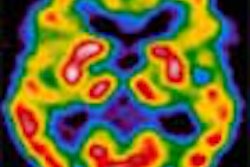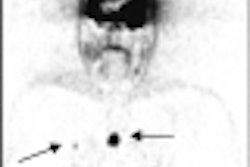CHICAGO - No company has been more active in the consolidation of the medical imaging market than Philips Medical Systems, which has purchased Marconi Medical Systems, ADAC Laboratories, and Agilent Technologies' Healthcare Solutions Group in the last year. The results of the integration are prominent in the Best, Netherlands-based firm's booth, one of the biggest on the exhibit floor.
Although Marconi and ADAC had some product overlap, Philips emphasized that it continues to sell everything from both, giving the company one of the broadest product lines in nuclear medicine.
Philips is putting the spotlight on Gemini, an open-design, integrated CT/PET system. Philips had demonstrated the unit prior to the Marconi acquisition, but the deal gave the company the ability to use a Marconi Mx8000 multislice scanner in the system rather than the single-slice unit previously used. The PET side of the hybrid unit is an Allegro camera with gadolinium oxyorthosilicate (GSO) detectors.
Philips is highlighting the open nature of Gemini’s design. When the systems are docked for hybrid scanning, there is an open gap between the CT and PET components, unlike other combo units. The design could be a benefit for claustrophobic patients, and also opens the possibility for interventional studies. Gemini has received FDA 510(k) clearance, with shipments starting in late 2002, according to Josh Gurewitz, senior director of marketing in nuclear medicine and PET for the company’s nuclear medicine division in Milpitas, CA.
Another new Philips nuclear medicine product is CardioMD, a 90-degree dual-head gamma camera for dedicated cardiac studies conducted in small facilities and private practices.
Also taking center stage is Philips' work-in-progress Infinite Detector Technology, deployed on its Mx8000 multislice CT scanner. With the addition of IDT, Mx8000 can collect 16 slices of data simultaneously, and 38 slices of data per second thanks to its 0.42-second rotation time.
This enables Mx8000 with IDT to cover more than 4 cm of patient anatomy in one second with submillimeter isotropic accuracy, according to Jim Green, vice president of CT for the company. IDT makes use of what Philips calls Tach technology, an application-specific integrated circuit (ASIC) that transfers data from the Mx8000 detector array at rate of 1 GB per second. Tach also locates the analog-to-digital conversion process closer the CT sensor, reduces noise caused during data transfer and enables the system to generate better images with less radiation dose.
Philips believes that IDT also offers the future possibility of 32-slice and 64-slice acquisition. Philips will begin shipping the IDT-equipped Mx8000 scanner in mid-2002. The company said that installed Mx8000 scanners will be upgradable to IDT.
Philips is also dipping its toe into the North American mammography market by introducing MammoDiagnost, a new system already being sold in Europe, according to Timothy Stevener, director of the company’s radiology business unit.
MammoDiagnost features a slim tube-head and narrow base, as well as a motorized gantry. Optional features include stereotactic biopsy guidance and DICOM compatibility.
MammoDiagnost will begin shipping in North America in the second half of 2002, according to Philips. As a step towards digital mammography, MammoDiagnost may also be connected to a digital radiology network via Philips computed radiography, although this feature is not yet available in the U.S.
In digital radiography developments, Philips rolled out DigitalDiagnost VR chest system. DigitalDiagnost VR includes a 17 x 17-inch flat-panel detector with a viewable image matrix of 3,000 x 3,000 pixels. Philips has seen a big jump in DR shipments since mid-2001 thanks to increased manufacturing capacity at Trixell, which makes panels for the Philips systems.
A software image processing solution for DR, Unique uses what Philips describes as harmonized contrast to provide optimum image contrast over the whole image. Unique will be available as an option on new DR systems, and as an upgrade to the vendor's installed base. In computed radiography, Compano S is a new entry-level version of the company’s Compano desktop CR system targeted at international markets.
In MRI, Philips has integrated Marconi’s MRI product line into its portfolio, displaying its complete family of scanners. Philips is emphasizing the high-performance aspects of the Intera product line, and the open features of the systems formerly marketed by Marconi. The only Marconi product dropped after the acquisition was Marconi’s 3-tesla scanner, which duplicated Philips’ own work in ultra-high-field MRI.
Philips has also enhanced its SENSE MR image acquisition technique, which now offers a four-fold improvement in acquisition time over traditional methods. A new line of optimized SENSE coils has also been introduced. SENSE will be available as an option on all new Intera and Panorama scanners ranging from 0.23-tesla to 3-tesla.
Intera IT is a new interventional MRI system that can be integrated with an x-ray unit to form XMR interventional suites, according to Michael Brandt, senior field marketing manager for MRI. A feature of the system is a special patient table than can float from the MRI magnet to the x-ray system. Philips also displayed whole-body 3-tesla imaging as a work-in-progress.
In ultrasound, Philips XRES image processing algorithm highlighted introductions this year. The integration of Agilent's Healthcare Solutions Group is progressing quite smoothly, according to company officials.
In PACS, Philips is highlighting its commitment to the RSNA's and HIMSS' Integrating the Healthcare Enterprise (IHE) initiative. The addition of plug-in capabilities are among new workstation enhancements.
By Erik L. Ridley and Brian Casey
AuntMinnie.com staff writers
November 28, 2001
For the rest of our coverage of the 2001 RSNA meeting, go to our RADCast@RSNA 2001.
Copyright © 2001 AuntMinnie.com



















